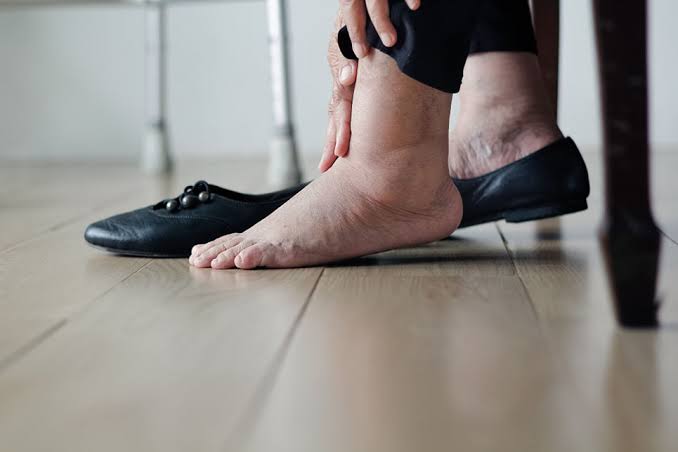How to deal with swollen feet for older women

To manage swollen feet, start by reducing your salt intake and drinking more water to minimize fluid buildup. Choose footwear that’s wide and made from breathable materials; tight shoes can worsen swelling.
Engage in regular, gentle exercises like walking or water aerobics to boost circulation. Elevating your feet above heart level several times a day can also help.
Consider using compression stockings for added support and relief. If your symptoms persist or worsen, it’s important to consult a doctor to rule out underlying health issues. You’ll find that a supportive community can offer further practical advice and encouragement.
Adjusting Your Diet
Altering your diet can greatly reduce swelling in your feet by improving your body’s fluid balance. Start by reducing your salt intake, as too much salt can cause your body to retain water. Instead of reaching for that salt shaker, why not try herbs and spices to flavor your meals? You’ll be surprised at how quickly your taste buds adjust and appreciate the new flavors.
Increasing your water intake can help flush out excess sodium and toxins from your body. It might sound counterintuitive to drink more when you’re experiencing swelling, but staying hydrated is key.
Join others who’ve found relief through these simple changes, and you’ll feel like you’re part of a supportive community working towards better health together.
Importance of Exercise
Regular exercise can noticeably alleviate swelling in your feet by boosting circulation and reducing fluid buildup. Engaging in physical activities isn’t just about staying fit; it’s about nurturing your body and fostering a sense of community. When you move, you’re not alone.
● Join a walking group: Feel the joy of companionship and shared goals.
● Attend water aerobics classes: Experience the support and gentle encouragement of your peers.
● Practice yoga or Tai Chi: Connect spiritually and emotionally with others in a tranquil environment.
● Participate in chair exercises: Even when you’re seated, you’re part of a circle of friends working towards better health together.
Proper Footwear Choices
Selecting the appropriate footwear is essential for minimizing foot swelling and improving comfort. You’re not alone in this; many women experience similar issues. It’s important to choose shoes with a wide, flexible fit that allow your feet room to expand throughout the day.
Look for materials that breathe well, like soft leather or canvas, to prevent moisture buildup that can worsen swelling. Avoid high heels or tight shoes that constrain your feet. Instead, opt for supportive, low-heeled or flat shoes with cushioned insoles that distribute pressure evenly.
You’ll feel part of a community that values both comfort and style. Remember, taking care of your feet isn’t just about comfort; it’s about maintaining your freedom and mobility as you enjoy your activities. For a wide selection of footwear that meets these criteria, check out Orthoticshop.
Compression Stockings Use
To manage foot swelling effectively, consider wearing compression stockings, which can greatly reduce discomfort and improve circulation. These specialized socks are designed to help you, ensuring that your legs feel lighter and more revitalized throughout the day. It’s about embracing a solution that supports not just your health, but also your desire to stay active and involved.
● Feel Understood: You’re not alone; many women experience this, and compression stockings are a tried and true remedy.
● Stay Active: With reduced swelling, engage more comfortably in activities you love.
● Boost Confidence: Look and feel better as you manage your symptoms with ease.
● Experience Comfort: Embrace the relief and comfort that comes from less swelling and pain.
Home Remedies Explored
Several home remedies can be effective in reducing the discomfort of swollen feet for older women. You’re not alone in this; many share your experience, and they’ve found solace in simple, natural treatments that can be done at home.
Here are a few you might find comforting:
● Soak your feet in Epsom salts: This can relax your muscles and reduce swelling.
● Massage with essential oils: Lavender or chamomile oil can soothe and lessen inflammation.
● Wear compression socks: These can help improve your circulation.
● Stay hydrated: Drinking enough water helps flush out excess salts, reducing puffiness.
When to See a Doctor
You should consult a doctor if your swollen feet are accompanied by pain, persistent swelling, or other concerning symptoms. It’s important to remember you’re not alone in this; many women experience similar issues, especially as they age.
A healthcare professional can offer you personalized advice and treatment options that align with your specific health needs. If your swelling suddenly worsens or you notice other symptoms like redness, warmth, or changes in skin color, it’s vital to seek medical attention immediately. These could be signs of a more serious condition, such as a blood clot or infection.
Conclusion
As you sail through your golden years, don’t let swollen feet anchor you down. Adjust your diet, keep moving, and choose the right shoes to stay afloat.
Compression stockings and elevated rest can also calm the tides.Explore simple home remedies to soothe your soles, but remember, if the waters get too rough, it’s time to call in a professional.
By taking these steps, you’ll keep your footing steady and enjoy smoother sailing ahead.



